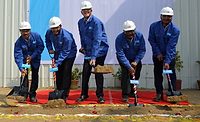GEW Collaborates with BJS to Double Production Capacity with New Wood Coating Line

BJS Czech s.r.o. was formed in 2005 and has become one of the largest furniture producers in the Czech Republic. Image courtesy of GEW.
UV systems manufacturer GEW, in partnership with furniture producer BJS Czech s.r.o., has successfully integrated a GEW LeoLED UV curing system onto an advanced wood coating line at BJS’s Humpolec plant in the Czech Republic. The new line, which features soft-roller coating technology combined with UV LED curing, has doubled productivity compared to conventional spray-coating and oven-drying processes.
BJS Czech s.r.o., part of the Swedish industrial group BJS Group AB, was established in 2005 and is now one of the largest furniture producers in the Czech Republic. Specializing in high-quality flatpack furniture finished with pigmented lacquers, the company continues to innovate through ongoing investment in advanced technologies.
Improved Efficiency and Sustainability
Filip Linsbauer, technical manager at BJS Czech, highlighted the inefficiency of traditional spray-coating methods: “Conventionally we use spraying technology to apply several layers of paint on the parts. We had to run through the line two times, and there was a lot of waste of material along the way because of inefficiency in the spraying process. We were challenged by our customer to push the technology a little bit further, which led to the new setup of the roller coating line.”
Soft-roller coating technology, combined with GEW’s UV LED curing, enables furniture components to be fully coated in a single pass. Hana Kudrnová, business development manager at BJS, explained: “In the past, with spraying technology, for our main product, we had to pass the components four times to cover both surfaces. Using the soft rollers with 100% UV cure by LED lamps, we can now coat one surface in one pass.”
Energy Savings and Reduced Waste
The UV LED curing system was chosen over conventional UV arc lamps for its substantial energy savings and reduced carbon footprint. Linsbauer noted additional benefits: “LEDs can start and be switched off immediately. If parts are not coming through the line, we can react almost instantaneously to these situations and stop the curing process, saving energy. You cannot do this with conventional lamps. Better control over the process significantly reduces scrap.”
The new technology has cut overall energy consumption on the line by 30%, while doubling production capacity. BJS has also installed an energy management system to monitor consumption and share data with its environmentally focused customer, which encourages sustainable practices.
 Production capacity has been doubled on the line with UV LED; overall energy consumption has been reduced by 30%. Image courtesy of GEW.
Production capacity has been doubled on the line with UV LED; overall energy consumption has been reduced by 30%. Image courtesy of GEW. “Our customer is really building their brand on environmental friendliness,” Linsbauer said. “We’ve taken samples of production with the old and new technologies, and the new line reduced energy consumption by 30%. Our customer is encouraging us to replace all conventional lamps with LEDs by the end of 2027.”
Enhanced Sustainability and Cost Savings
Kudrnová emphasized the sustainability benefits: “This investment gives us the opportunity to double our capacity, save energy, reduce lacquer waste, and avoid higher waste levels. From a sustainability point of view, it’s huge progress.”
BJS plans to continue its transition to LED technology while leveraging data from GEW’s monitoring system and its own energy management tools to quantify and communicate the savings achieved.
For the full article visit www.gewuv.com/bjs.
Looking for a reprint of this article?
From high-res PDFs to custom plaques, order your copy today!








